Microstructural Characteristics of Frazil Particles and the Physical Properties of Frazil Ice in the Yellow River, China
Abstract
1. Introduction
2. Materials and Methods
2.1. Technology of Unidirectional Freezing
2.2. Preparation of Frazil Ice Materials
2.3. Observation Method of Frazil Particles Morphology
2.4. Ice Crystal Microstructure and Air Bubble Observation Method
2.5. Ice Density and Mud Content Observation Methods
3. Results
3.1. Frazil Ice Nucleation
3.2. Microstructural Characteristics of Single Frazil Particles
3.3. Microstructural Characteristics of Accumulated Frazil Particles
3.4. Ice Crystal Microstructure and Air Bubble in Frazil Ice
3.5. Ice Density and Sediment Content in Ice
4. Conclusions
- (1)
- Frazil ice nuclei can be ice particles or other cold particles, such as microbubbles, organic material, or sediment particles;
- (2)
- Based on their shape, diameter, slenderness ratio, and roundness, the frazil particles may be divided into four types as seen in Table 1, where each has its own characteristic parameters;
- (3)
- A large number of frazil particles may agglomerate in turbulent streams. As the number of agglomerated particles increases, the maximum angle between two adjacent frazil particles will gradually decrease;
- (4)
- Following the unidirectional freezing technology summarized in the laboratory, unidirectionally_frozen frazil and columnar ice were obtained. Compared with the columnar ice, the ice crystal structure of frazil ice is disorderly; the crystal size is small; and the diameter is 2.2–2.6 mm;
- (5)
- Ice density is affected by both the bubble and sediment contents. The nucleation mechanism of frazil particles, coupled with the large amount of sediment in the Yellow River, resulted in significantly larger bubbles and sediment content in frazil ice than in columnar ice.
Author Contributions
Funding
Data Availability Statement
Acknowledgments
Conflicts of Interest
References
- Li, L.; Huo, T.; Shen, G.; Zhang, B.; Li, Z.; Zhang, Y. Analysis of the influencing factors of ice thickness growth in Toudaoguai section of the Yellow River in 2019 and 2020. Yellow River 2021, 43, 58–62. [Google Scholar]
- Wang, T.; Liu, Z.; Guo, X.; Fu, H.; Liu, W. Prediction of breakup ice jam with Artificial Neural Networks. J. Hydraul. Eng. 2017, 48, 1355–1362. [Google Scholar]
- Arden, R.S.; Wigle, T.E. Dynamics of ice formation in the upper Niagara River. In The Role of Snow and Ice in Hydrology, Proceedings of the IAHS-UNESCO-WMO Conference, Banff, Proc; Unesco-WMO-IAHS: Geneva, Switzerland, 1972; pp. 1296–1313. [Google Scholar]
- Daly, S.F. Frazil ice. In Proceedings of the CGU-HS Conference, Edmonton, AB, Canada, 21–24 July 2013; pp. 107–134. [Google Scholar]
- Yang, K. Advances of ice hydraulics, ice regime observation and forecasting in rivers. J. Hydraul. Eng. 2018, 49, 81–91. [Google Scholar]
- Gaufin, A.R. Production of bottom fauna in the Provo River, Utah. Iowa St. coll. J. Sci. 1959, 33, 395–419. [Google Scholar] [CrossRef]
- Jenkins, A.; Bombosch, A. Modeling the effects of frazil ice crystals on the dynamics and thermodynamics of Ice Shelf Water plumes. J. Geophys. Res. Space Phys. 1995, 100, 6967–6981. [Google Scholar] [CrossRef]
- Hanley, T.O.D. Frazil nucleation mechanisms. J. Glaciol. 1978, 21, 581–587. [Google Scholar] [CrossRef][Green Version]
- Daly, S.F. Evolution of frazil ice. In Proceedings of the 19th IAHR International Symposium on Ice, Vancouver, BC, Canada, 6–11 July 2008; pp. 29–47. [Google Scholar]
- Michel, B. Theory of formation and deposit of frazil ice. In Proceedings of the Annual Eastern Snow Conference, Quebec City, QC, Canada, 14–15 February 1963; pp. 3–18. [Google Scholar]
- Hanley, T.O.D.; Tsang, G. Formation and properties of frazil in saline water. Cold Reg. Sci. Technol. 1984, 8, 209–221. [Google Scholar] [CrossRef]
- Ye, S.Q.; Doering, J.; Shen, H.T. A laboratory study of frazil evolution in a counter-rotating flume. Can. J. Civ. Eng. 2004, 31, 899–914. [Google Scholar] [CrossRef]
- Clark, S.; Doering, J.C. A laboratory study of frazil ice size distributions. In Proceedings of the 17th International Symposium on Ice, Saint Petersburg, Russia, 21–25 June 2004; pp. 291–297. [Google Scholar]
- Clark, S.; Doering, J.C. Laboratory experiments on frazil-size characteristics in a counter rotating flume. J. Hydraul. Eng. 2006, 132, 94–101. [Google Scholar] [CrossRef]
- Ghobrial, T.R.; Loewen, M.R.; Hicks, F. Laboratory calibration of upward looking sonars for measuring suspended frazil ice concentration. Cold Reg. Sci. Technol. 2012, 70, 19–31. [Google Scholar] [CrossRef]
- Tsang, G.; Cui, W. Laboratory study of frazil distribution in a flow. Can. J. Civ. Eng. 1994, 21, 696–709. [Google Scholar] [CrossRef]
- Ettema, R.; Karim, M.F.; Kennedy, J.F. Frazil Ice Formation; U.S. Army Cold Regions Research and Engineering Laboratory: Hanover, NH, USA, 1984. [Google Scholar]
- Ettema, R.; Karim, M.; Kennedy, J. Laboratory experiments on frazil ice growth in supercooled water. Cold Reg. Sci. Technol. 1984, 10, 43–58. [Google Scholar] [CrossRef]
- Clark, S.; Doering, J. Experimental investigation of the effects of turbulence intensity on frazil ice characteristics. Can. J. Civ. Eng. 2008, 35, 67–79. [Google Scholar] [CrossRef]
- McFarlane, V.; Loewen, M.; Hicks, F. Measurements of the evolution of frazil ice particle size distributions. Cold Reg. Sci. Technol. 2015, 120, 45–55. [Google Scholar] [CrossRef]
- Wueben, J.L. The rise pattern and velocity of frazil ice. In Proceedings of the 3rd Workshop on the Hydraulics of Ice Covered Rivers, Fredericton, NB, Canada, 20–21 June 1984; pp. 297–316. [Google Scholar]
- Reimnitz, E.; Clayton, J.R.; Kempema, E.W.; Payne, J.R.; Weber, W.S. Interaction of rising frazil with suspended particles: Tank experiments with applications to nature. Cold Reg. Sci. Technol. 1993, 21, 117–135. [Google Scholar] [CrossRef]
- Osterkamp, T.E. Frazil-Ice nucleation by mass-exchange processes at the air-water interface. J. Glaciol. 1977, 19, 619–627. [Google Scholar] [CrossRef]
- Schaefer, V.J. The formation of frazil and anchor ice in cold water. Trans. Am. Geophys. Union 1950, 31, 885–893. [Google Scholar] [CrossRef]
- Osterkamp, T.; Gosink, J. Frazil ice formation and ice cover development in interior Alaska streams. Cold Reg. Sci. Technol. 1983, 8, 43–56. [Google Scholar] [CrossRef]
- Dubé, M.; Turcotte, B.; Morse, B. Inner structure of anchor ice and ice dams in steep channels. Cold Reg. Sci. Technol. 2014, 106–107, 194–206. [Google Scholar] [CrossRef]
- Kempema, E.W.; Ettema, R. Fish, ice, and wedge-wire screen water intakes. J. Cold Reg. Eng. 2016, 30, 04015004. [Google Scholar] [CrossRef]
- McFarlane, V.; Loewen, M.; Hicks, F. Measurements of the size distribution of frazil ice particles in three Alberta rivers. Cold Reg. Sci. Technol. 2017, 142, 100–117. [Google Scholar] [CrossRef]
- Richard, M.; Morse, B.; Daly, S.F.; Emond, J. Quantifying suspended frazil ice using multi-frequency underwater acoustic devices. River Res. Appl. 2010, 27, 1106–1117. [Google Scholar] [CrossRef]
- Ghobrial, T.R.; Loewen, M.R.; Hicks, F.E. Characterizing suspended frazil ice in rivers using upward looking sonars. Cold Reg. Sci. Technol. 2013, 86, 113–126. [Google Scholar] [CrossRef]
- Marko, J.; Jasek, M.; Topham, D.R. Multifrequency analyses of 2011–2012 Peace River SWIPS frazil backscattering data. Cold Reg. Sci. Technol. 2015, 110, 102–119. [Google Scholar] [CrossRef]
- Omstedt, A.; Svensson, U. Modeling supercooling and ice formation in a turbulent Ekman layer. J. Geophys. Res. Space Phys. 1984, 89, 735–744. [Google Scholar] [CrossRef]
- Omstedt, A. On supercooling and ice formation in turbulent sea water. J. Glaciol. 1985, 31, 263–271. [Google Scholar] [CrossRef][Green Version]
- Omstedt, A. Modelling frazil ice and grease ice formation in the upper layers of the ocean. Cold Reg. Sci. Technol. 1985, 11, 87–98. [Google Scholar] [CrossRef]
- Hammar, L.; Shen, H.T. Frazil evolution in channels. J. Hydraul. Res. 1995, 33, 291–306. [Google Scholar] [CrossRef]
- Makkonen, L.; Tikanmäki, M. Modelling frazil and anchor ice on submerged objects. Cold Reg. Sci. Technol. 2018, 151, 64–74. [Google Scholar] [CrossRef]
- Morse, B.; Richard, M. A field study of suspended frazil ice particles. Cold Reg. Sci. Technol. 2009, 55, 86–102. [Google Scholar] [CrossRef]
- Daly, S.F.; Colbeck, S.C. Frazil ice measurements in CRREL’s flume facility. In Proceedings of the IAHR Ice Symposium 1986, International Association for Hydraulic Research, Iowa City, IA, USA, 18–22 August 1986; pp. 427–438. [Google Scholar]
- Huang, W. Study on Lake Ice Microstructure and Its Effects on Thermal and Mechanical Parameters. Ph.D. Thesis, University of Dalian Technology, Dalian, China, 2013. [Google Scholar]
- Huang, W.; Li, Z.; Liu, X.; Zhao, H.; Guo, S.; Jia, Q. Effective thermal conductivity of reservoir freshwater ice with attention to high temperature. Ann. Glaciol. 2013, 54, 189–195. [Google Scholar] [CrossRef]
- Timco, G.; Weeks, W. A review of the engineering properties of sea ice. Cold Reg. Sci. Technol. 2010, 60, 107–129. [Google Scholar] [CrossRef]
- Li, Z.; Zhang, L.; Lu, P.; Leppäranta, M.; Li, G. Experimental study on the effect of porosity on the uniaxial compressive strength of sea ice in Bohai Sea. Sci. China Ser. E Technol. Sci. 2011, 54, 2429–2436. [Google Scholar] [CrossRef]
- Shi, L.; Li, Z.; Niu, F.; Huang, W.; Lu, P.; Feng, E.; Han, H. Thermal diffusivity of thermokarst lake ice in the Beiluhe basin of the Qinghai–Tibetan Plateau. Ann. Glaciol. 2014, 55, 153–158. [Google Scholar] [CrossRef]
- Deng, Y.; Li, Z.; Wang, J.; Xu, L. The microstructure of yellow river ice in the freezing period. Crystals 2019, 9, 484. [Google Scholar] [CrossRef]
- Zhang, Y.; Gao, G.; Deng, Y.; Li, Z.; Guo, W. Investigation on ice crystal, density and sediment content in ice at different positions in Bayannaoer Section of the Yellow River. Yellow River 2018, 40, 44–48. [Google Scholar]
- Li, Z.; Wang, Z.; Wang, Q.; Xie, F.; Lu, P. Laboratory study on parameterization of ice floe melt rate at ice-air and ice-water interfaces. Acta Oceanol. Sin 2021. accepted. [Google Scholar]
- Song, S. Optics and Thermal Characteristics of Wuliangsuhai During the Frozen Period and the Primary Productivity in the Water Under Ice. Ph.D. Thesis, Inner Mongolia Agricultural University, Hohhot, China, 2019. [Google Scholar]
- Morris, M.P. A Digital Image Processing System for The Characterization of Frazil Ice. Ph.D. Thesis, University of Manitoba, Winnipeg, MB, Canada, 2003. [Google Scholar]
- McFarlane, V.; Loewen, M.; Hicks, F. Laboratory measurements of the rise velocity of frazil ice particles. Cold Reg. Sci. Technol. 2014, 106–107, 120–130. [Google Scholar] [CrossRef]
- Zhang, Y. Study on the Internal Structure and Surface Fracture Characteristics of River Ice. Master’s Thesis, University of Shenyang Agricultural, Shenyang, China, 2019. [Google Scholar]
- Langway, C.C. Ice fabrics and the universal stage. In Technical Report 62; Department of Defense, Department of the Army, Corps of Engineers, Snow Ice and Permafrost Research Establishment: Wilmette, IL, USA, 1959. [Google Scholar]
- Timco, G.W.; Frederking, R.M.W. A review of sea ice density. Cold Reg. Sci. Technol. 1996, 24, 1–6. [Google Scholar] [CrossRef]
- Turner, W.R. Microbubble persistence in fresh water. J. Acoust. Soc. Am. 1961, 33, 1223–1233. [Google Scholar] [CrossRef]
- Caupin, F.; Herbet, E. Cavitation in water: A review. C. R. Phys. 2006, 7, 1000–1017. [Google Scholar] [CrossRef]
- Chow, R.; Mettin, R.; Lindinger, B.; Kurz, T.; Lauterborn, W. The importance of acoustic cavitation in the sonocrystallisation of ice-high speed observations of a single acoustic bubble. IEEE Symp. Ultrason. 2004. [Google Scholar] [CrossRef]
- Kempema, E.; Reimnitz, E.; Hunter, R. Flume Studies and Field Observations of the Interaction of Frazil Ice and Anchor Ice with Sediments; U.S. Geological Survey: Reston, VA, USA, 1986. [CrossRef]
- Michel, B.; Ramseier, R.O. Classification of river and lake ice. Can. Geotech. J. 1971, 8, 36–45. [Google Scholar] [CrossRef]
- Müller-Stoffels, M.; Langhorne, P.J.; Petrich, C.; Kempema, E.W. Preferred crystal orientation in fresh water ice. Cold Reg. Sci. Technol. 2009, 56, 1–9. [Google Scholar] [CrossRef]
- Zhang, Y.; Li, Z.; Li, C.; Zhang, B.; Deng, Y. Microstructure characteristics of river ice in Inner Mongolia section of The Yellow River. J. Hydraul. Eng. 2021. accepted. [Google Scholar]
- Carte, E.A. Air bubbles in ice. Proc. Phys. Soc. 1961, 77, 757–768. [Google Scholar] [CrossRef]
- Light, B.; Maykut, G.A.; Grenfell, T.C. Effects of temperature on the microstructure of first-year Arctic sea ice. J. Geophys. Res. Space Phys. 2003, 108, 3051–3066. [Google Scholar] [CrossRef]
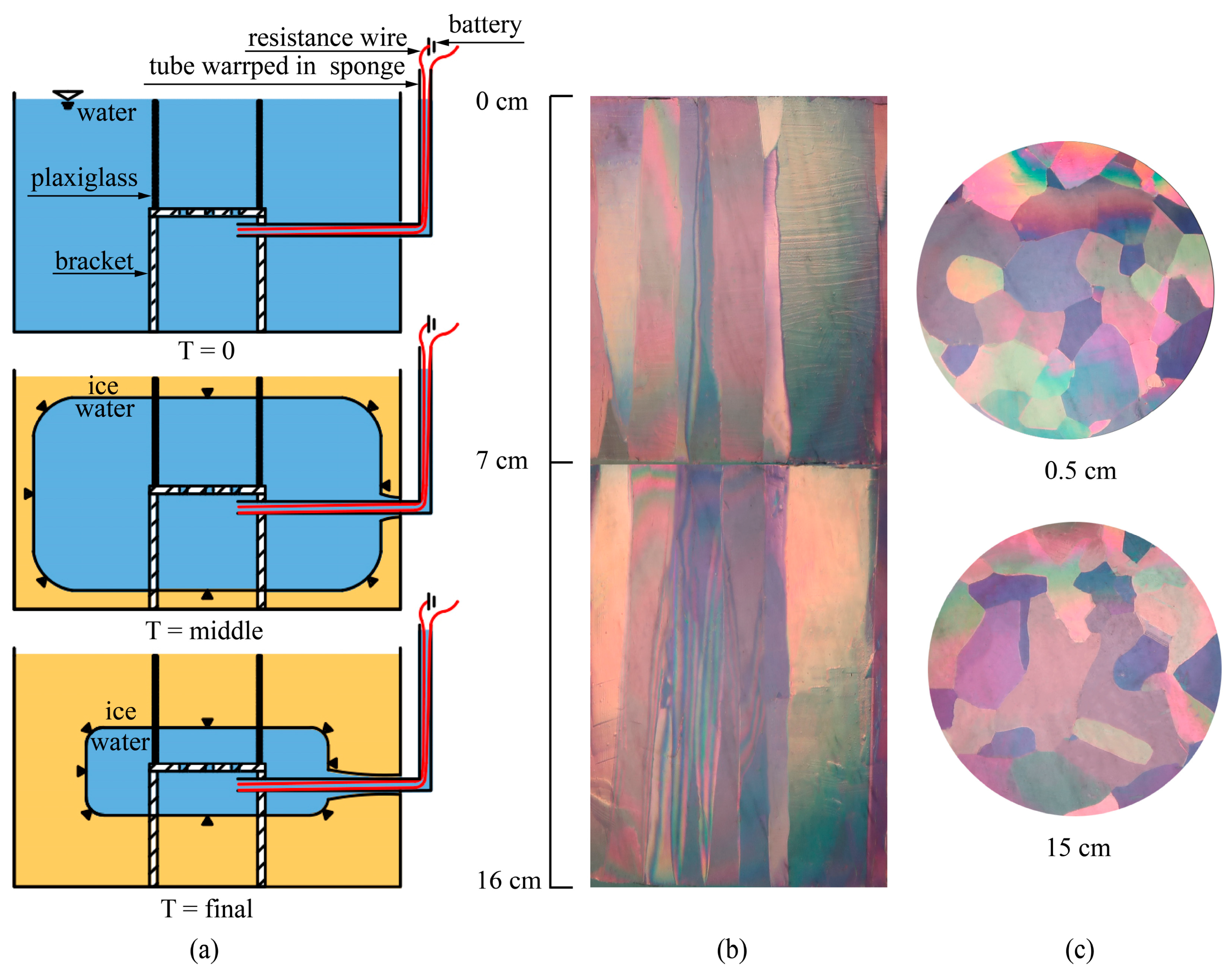
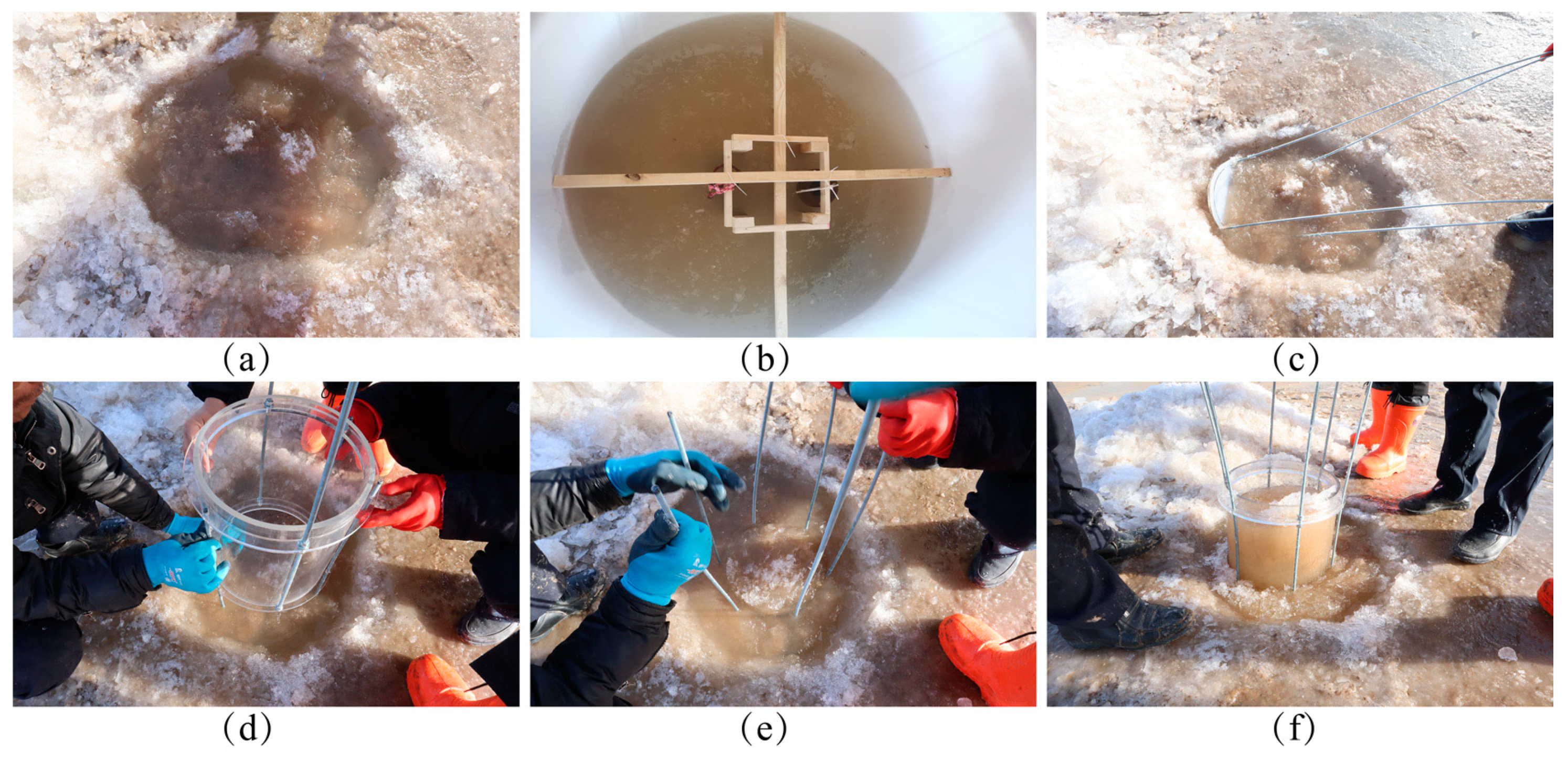

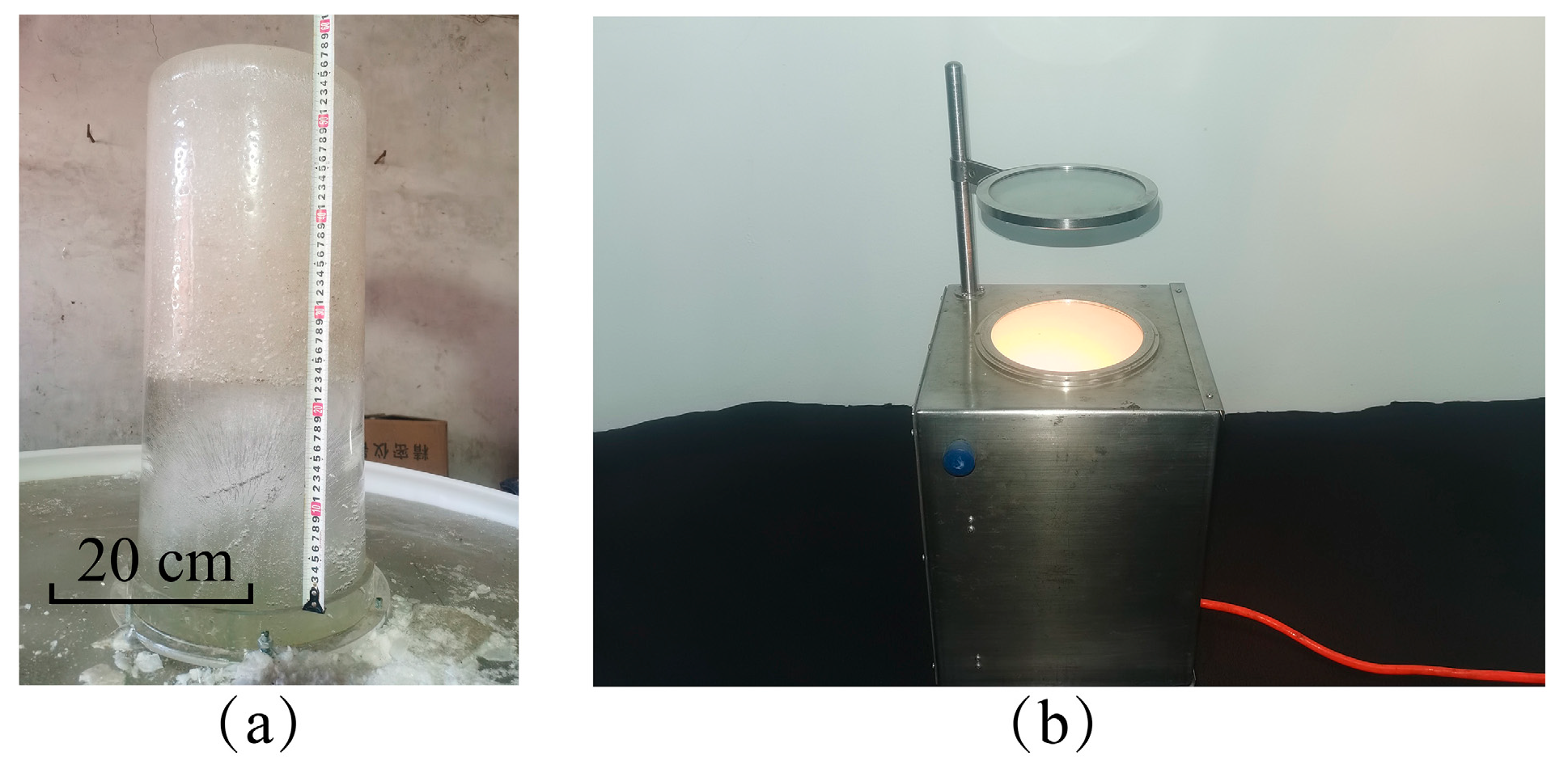
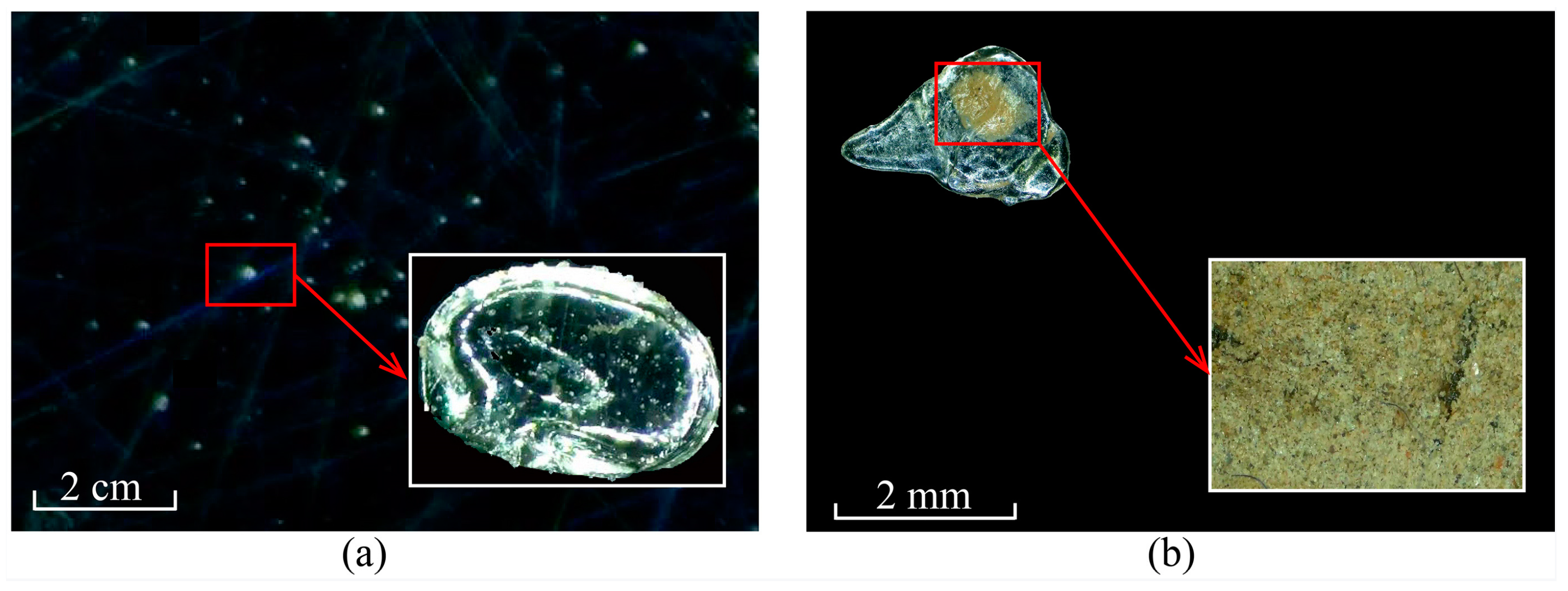

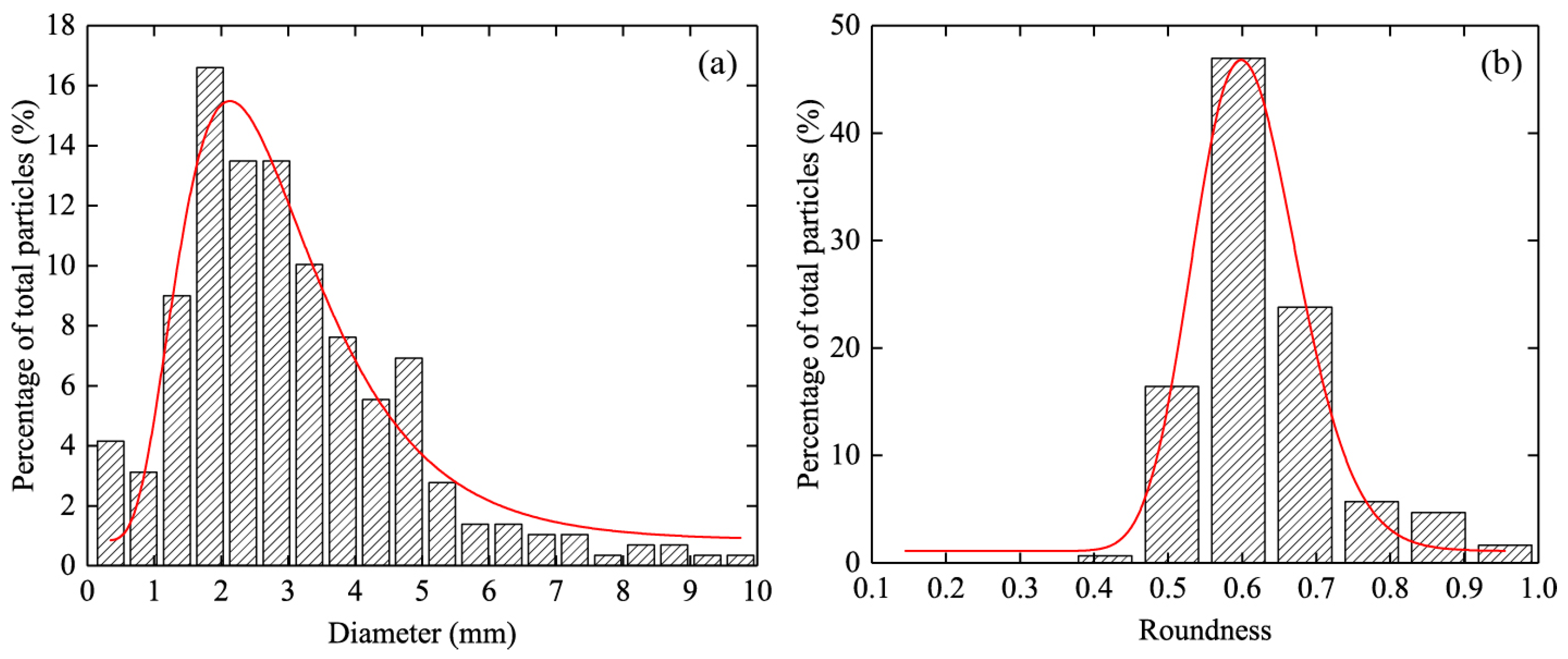



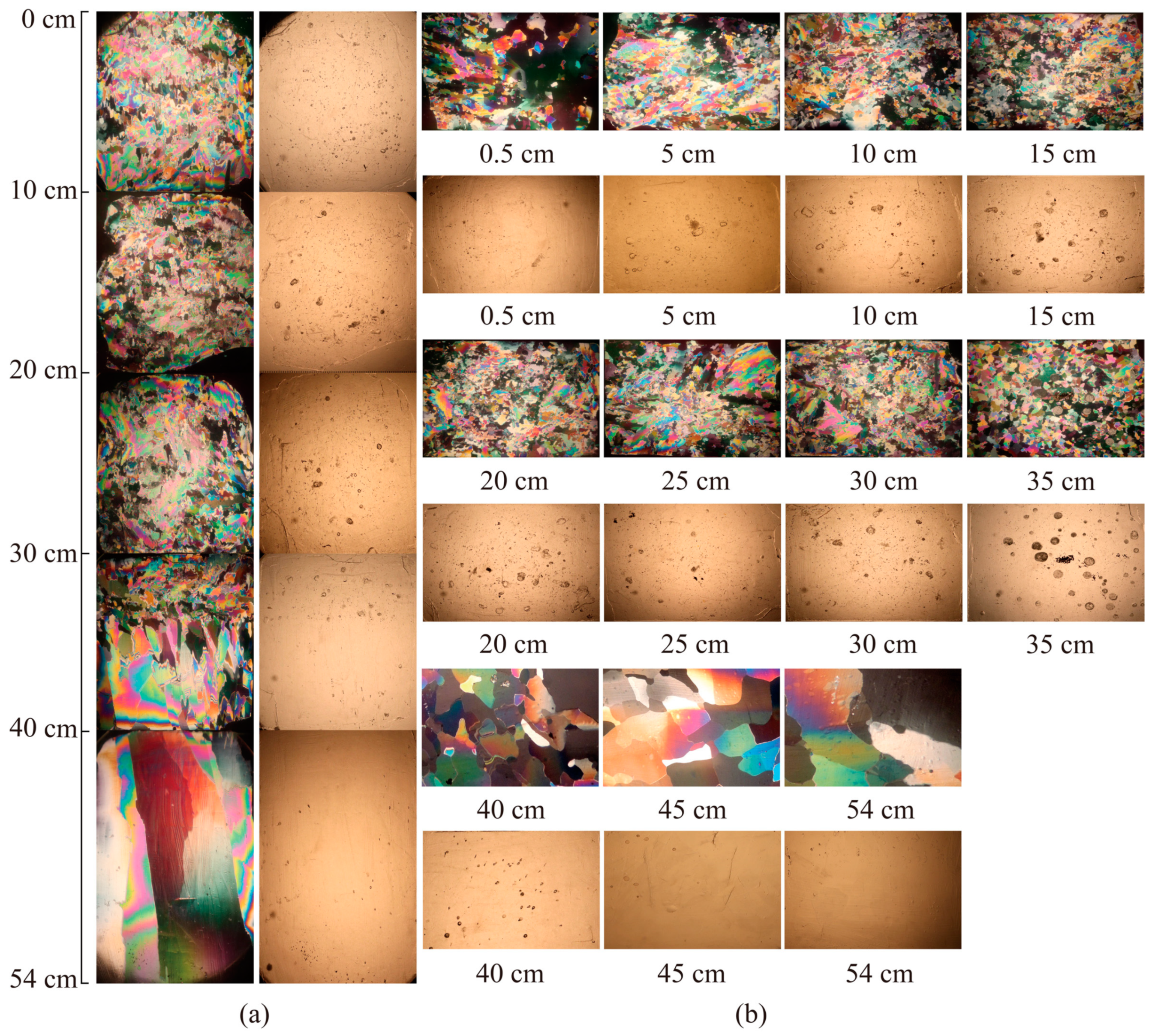

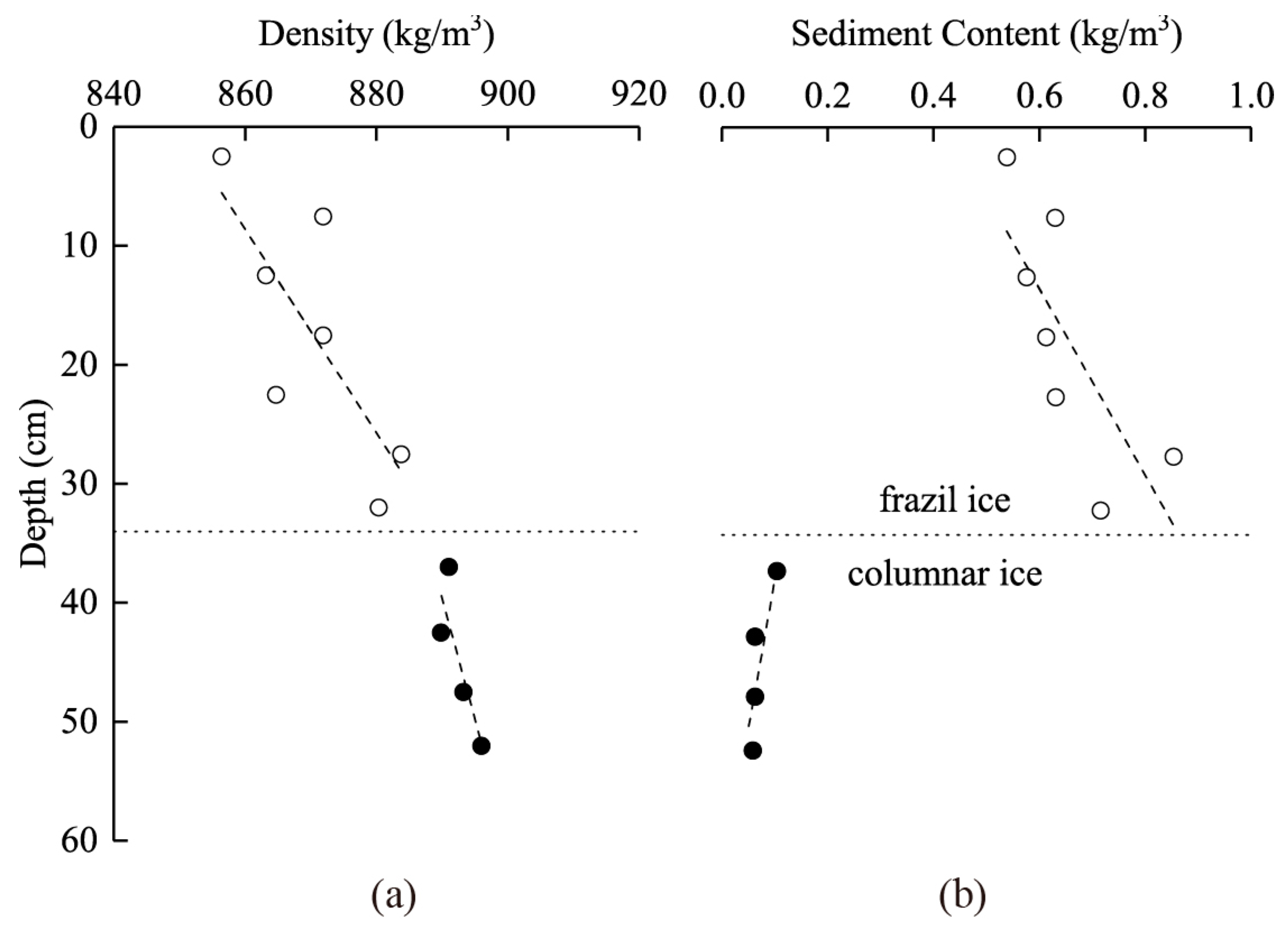
| Shape | # of Images | Percentage (%) | Diameter (mm) | Slenderness Ratio | Roundness |
|---|---|---|---|---|---|
| Granular | 298 | 77.8 | 3.2 ± 2.1 | 0.6 ± 0.1 | 0.6 ± 0.1 |
| Serrated | 43 | 11.2 | 15.6 ± 4.3 | 0.3 ± 0.1 | 0.3 ± 0.1 |
| Needle-like | 35 | 9.2 | 8.3 ± 2.6 | 0.2 ± 0.1 | 0.2 ± 0.1 |
| Dendritic | 7 | 1.8 | 14.1 ± 3.2 | 0.3 ± 0.1 | 0.2 ± 0.1 |
Publisher’s Note: MDPI stays neutral with regard to jurisdictional claims in published maps and institutional affiliations. |
© 2021 by the authors. Licensee MDPI, Basel, Switzerland. This article is an open access article distributed under the terms and conditions of the Creative Commons Attribution (CC BY) license (https://creativecommons.org/licenses/by/4.0/).
Share and Cite
Zhang, Y.; Li, Z.; Xiu, Y.; Li, C.; Zhang, B.; Deng, Y. Microstructural Characteristics of Frazil Particles and the Physical Properties of Frazil Ice in the Yellow River, China. Crystals 2021, 11, 617. https://doi.org/10.3390/cryst11060617
Zhang Y, Li Z, Xiu Y, Li C, Zhang B, Deng Y. Microstructural Characteristics of Frazil Particles and the Physical Properties of Frazil Ice in the Yellow River, China. Crystals. 2021; 11(6):617. https://doi.org/10.3390/cryst11060617
Chicago/Turabian StyleZhang, Yaodan, Zhijun Li, Yuanren Xiu, Chunjiang Li, Baosen Zhang, and Yu Deng. 2021. "Microstructural Characteristics of Frazil Particles and the Physical Properties of Frazil Ice in the Yellow River, China" Crystals 11, no. 6: 617. https://doi.org/10.3390/cryst11060617
APA StyleZhang, Y., Li, Z., Xiu, Y., Li, C., Zhang, B., & Deng, Y. (2021). Microstructural Characteristics of Frazil Particles and the Physical Properties of Frazil Ice in the Yellow River, China. Crystals, 11(6), 617. https://doi.org/10.3390/cryst11060617








